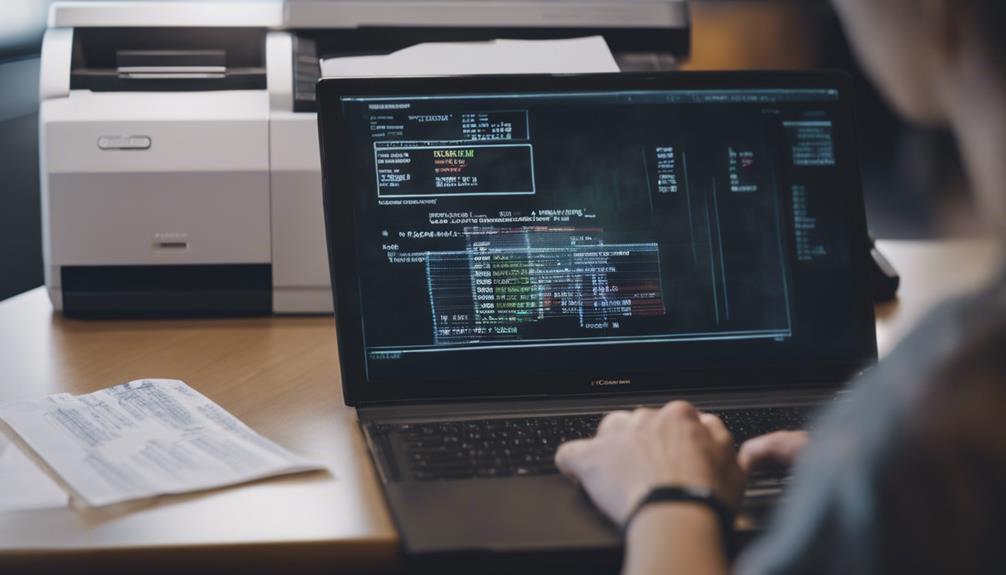In the world of data entry, ensuring the security of receipts is akin to safeguarding a treasure trove of information. However, it’s not just about locking away the data; it’s about implementing a comprehensive strategy that covers every aspect of data security. By following the ten essential steps outlined in this guide, you can fortify your receipts data entry process against potential threats and breaches. From understanding the data to revising security policies, each step plays a crucial role in building a robust defense.
Understand the Data
To ensure accurate and secure receipt data entry, it is crucial to thoroughly comprehend the information being input. Data analysis plays a vital role in this process. By understanding the type of data being entered, you can better categorize and organize it for efficient processing. It is essential to recognize patterns, anomalies, and trends within the data to ensure its accuracy and relevance.
Furthermore, information security is paramount when dealing with receipt data entry. Safeguarding sensitive information such as financial details and personal data is key to maintaining trust with customers and protecting the integrity of the data. Implementing encryption protocols, access controls, and regular security audits are crucial steps in ensuring that the data remains secure throughout the entry process.
Create a Secure System
To ensure the security of receipts data entry, you must implement robust data encryption measures to safeguard sensitive information. Establish strict access control policies to control who can view or modify the data, minimizing the risk of unauthorized access. Conduct regular security audits to identify and address any potential vulnerabilities in the system, maintaining a high level of data protection.
Data Encryption Measures
Consider implementing robust data encryption measures to establish a secure system for safeguarding sensitive receipt information. Utilizing encryption technologies can significantly enhance the protection of data during entry and storage. Implementing data protection strategies can further fortify the security of your receipt data against potential breaches. Encryption plays a crucial role in ensuring that unauthorized individuals cannot access or decipher the information contained within receipts. By employing encryption technologies, you can create an additional layer of defense against cyber threats, ensuring that your sensitive data remains confidential and secure.
- Utilize end-to-end encryption protocols.
- Implement strong encryption algorithms.
- Regularly update encryption keys to maintain security.
Access Control Policies
Enhance the security of your system by establishing stringent access control policies to regulate and monitor user interactions with sensitive receipt data. Access control management is crucial in preventing unauthorized access to confidential information. Implement role-based access control, where users are only granted permissions necessary for their specific tasks. Utilize multi-factor authentication to add an extra layer of security, requiring users to provide multiple credentials for access. Regularly review and update user access privileges to ensure that only authorized personnel can view or modify receipt data. By enforcing these access control policies effectively, you can significantly reduce the risk of data breaches and safeguard the integrity of your receipt data. Take proactive measures to protect your system and sensitive information.
Regular Security Audits
Establishing a secure system requires conducting regular security audits to assess vulnerabilities and ensure the robustness of your data protection measures. Regular penetration testing and vulnerability assessments are crucial components of these audits. By performing these tasks frequently, you can identify potential weaknesses in your system and address them promptly. Additionally, conducting security audits helps you stay compliant with industry regulations and standards, keeping your data safe from potential breaches. Remember that security is an ongoing process, and by regularly evaluating your systems, you can proactively protect your data and prevent unauthorized access. Stay vigilant and prioritize security to safeguard your sensitive information effectively.
Train Employees on Data Security
When training your employees on data security, ensure they understand the importance of handling sensitive information securely. Implement security measures that align with industry standards and the specific needs of your organization. By providing comprehensive training and practical guidance, you can strengthen your company’s defenses against potential data breaches.
Employee Training Importance
Training employees on data security protocols is crucial to ensure the guarantee of security in receipts data entry. Employee awareness plays a significant role in maintaining the integrity of sensitive information. By providing comprehensive training on security protocols, you equip your team with the knowledge and skills necessary to identify and mitigate potential risks effectively. Here are key reasons why employee training is vital:
- Prevention of Data Breaches: Educating employees on security protocols reduces the likelihood of data breaches.
- Enhanced Compliance: Training ensures that employees adhere to regulatory requirements, safeguarding confidential data.
- Improved Response to Security Incidents: Proper training enables swift and effective responses to security incidents, minimizing their impact on data integrity.
Security Measures Implementation
To ensure the effective implementation of security measures, prioritize educating employees on data security protocols. Training plays a crucial role in preventing data breaches and ensuring security protocol compliance within your organization. By educating your staff on the importance of following security measures, you can significantly reduce the risk of unauthorized access to sensitive information. Emphasize the significance of safeguarding data, recognizing potential threats, and adhering to established security protocols. Encourage employees to stay updated on evolving security practices and actively participate in maintaining a secure data environment. Through regular training sessions and clear communication of security expectations, you can create a culture of vigilance and responsibility that enhances overall data protection efforts.
Use Secure Software
How can you ensure the security of your receipt data entry process? Utilizing secure software is crucial in safeguarding your sensitive information. By implementing secure encryption protocols and robust data protection measures, you can significantly reduce the risk of unauthorized access and data breaches. Here are some key steps to consider:
- Encryption Techniques: Employ industry-standard encryption methods to encode your receipt data, making it unreadable to unauthorized users.
- Access Control: Implement strict access control mechanisms within the software to ensure that only authorized personnel can view or manipulate the data.
- Regular Updates: Keep your software up to date with the latest security patches and enhancements to address any vulnerabilities that could be exploited by cyber threats.
Regularly Monitor System
You should ensure that regular system security checks are conducted to identify any vulnerabilities or suspicious activities. Implement oversight measures for data entry to maintain accuracy and prevent unauthorized access. Determine the appropriate frequency for monitoring the system to stay ahead of potential security breaches.
System Security Checks
Regularly monitoring the system is crucial to ensuring ongoing security checks in the receipt data entry process. By actively monitoring the system, you can detect system vulnerabilities and potential data breaches promptly. Here are three key actions to enhance system security:
- Implement Intrusion Detection Systems: Set up software that monitors network or system activities for malicious activities or policy violations.
- Regularly Update Security Patches: Stay current with software updates to address known vulnerabilities and strengthen system defenses.
- Conduct Security Audits: Periodically review system logs and configurations to identify any irregularities or potential security gaps.
Consistent monitoring and proactive measures are essential to safeguarding sensitive receipt data.
Data Entry Oversight
To ensure robust security in receipt data entry, consistent oversight of the data entry system is imperative. Data entry accuracy plays a vital role in maintaining the integrity of the system. Regularly monitoring the data entry process helps in error prevention, ensuring that all information is entered correctly and securely. By actively overseeing the data entry procedures, you can identify and rectify any inaccuracies promptly, reducing the chances of data breaches or loss. Implementing strict oversight measures also promotes accountability among the data entry personnel, fostering a culture of precision and diligence. Monitoring the data entry system effectively safeguards sensitive information, enhancing the overall security of the receipt data entry process.
Monitoring Frequency
Consistent monitoring of the data entry system is essential to ensure the security and accuracy of receipt data entry. When it comes to security monitoring and data entry frequency, consider the following:
- Regular Audits: Conduct routine audits of the data entry system to identify any irregularities or unauthorized access.
- Real-time Alerts: Implement real-time alert systems that notify administrators of any suspicious activities or breaches.
- Periodic Reviews: Schedule periodic reviews of user access levels and permissions to prevent unauthorized changes to receipt data.
Maintain Backups
Ensuring the security of your receipt data entry involves implementing a systematic approach to maintaining backups of all crucial information. Backup storage is essential for safeguarding your data in case of unexpected events such as system failures, cyber-attacks, or accidental deletions. By regularly backing up your receipt data, you can prevent data loss and ensure business continuity.
To maintain backups effectively, it is crucial to establish a routine schedule for backing up your data. This schedule should take into account the frequency of data entry and the criticality of the information being stored. Additionally, it is advisable to store backups in multiple locations to mitigate the risk of data loss due to a single point of failure. Cloud storage services or external hard drives are commonly used for backup storage, providing secure and accessible options for storing important data.
Data protection is paramount when it comes to maintaining backups. Encrypting your backup files adds an extra layer of security, ensuring that even if unauthorized access occurs, the data remains protected. Regularly testing your backups to confirm their integrity and accessibility is also essential in guaranteeing that your receipt data can be recovered in case of emergencies. By following these practices, you can establish a robust backup system that secures your receipt data effectively.
Implement Data Encryption
Implementing data encryption is crucial for enhancing the security of your receipt data entry process. By utilizing encryption techniques, you can safeguard sensitive information from unauthorized access and ensure the confidentiality of your data. Here are some key strategies to consider when implementing data encryption:
- End-to-End Encryption: Utilize end-to-end encryption to protect data throughout its entire lifecycle, from entry to storage and transmission.
- Strong Encryption Algorithms: Employ robust encryption algorithms like AES (Advanced Encryption Standard) to secure your data effectively.
- Key Management: Implement proper key management practices to securely store and manage encryption keys, ensuring that only authorized individuals can access the encrypted data.
Regularly Update Security Measures
To enhance the security of your receipt data entry process effectively, maintain regular updates to your security measures. Updating protocols is crucial in staying ahead of potential security threats. Ensure that your software, firewalls, and antivirus programs are regularly updated to safeguard against the latest vulnerabilities. By staying current with these updates, you strengthen your data protection measures and reduce the risk of unauthorized access to sensitive information.
Regularly updating security measures involves more than just software updates. It also includes reviewing access controls, monitoring user activities, and enhancing password policies. Implementing multi-factor authentication can add an extra layer of security to your data entry process. Regularly reviewing and updating these measures will help fortify your defenses against cyber threats and potential breaches.
Review System for Breaches
Regularly monitoring your system for breaches is essential to maintaining the security of your receipt data entry process. Detecting breaches promptly allows for swift incident response, minimizing potential damage. Here are key points to consider:
- Breach Detection: Implementing robust monitoring tools and intrusion detection systems enhances your ability to identify any unauthorized access or suspicious activities promptly.
- Incident Response: Establishing a well-defined incident response plan ensures that your team knows how to react swiftly and effectively in the event of a breach, minimizing its impact on your receipt data security.
- Regular Testing: Conducting regular penetration testing and vulnerability assessments helps proactively identify weaknesses in your system, allowing you to address them before they can be exploited.
Regularly Revise Security Policies
Enhancing the security of your data entry process requires periodic review and revision of your security policies. Security training is essential to ensure that all employees are up to date with the latest security protocols and are aware of potential risks. Regularly scheduled training sessions can help reinforce the importance of following security procedures and highlight any changes in policy.
Policy updates should be conducted regularly to address new security threats and vulnerabilities. It is crucial to stay informed about emerging security trends and adjust your policies accordingly. By keeping your security policies current, you can better protect sensitive data during the receipts data entry process.
In addition to updating policies, it is important to communicate these changes effectively to all relevant staff members. Clear communication ensures that everyone understands their roles and responsibilities in maintaining data security. Regularly revising security policies is a proactive approach to safeguarding your data entry process against potential security breaches.
Frequently Asked Questions
How Can I Ensure That My Employees Are Following Proper Data Security Protocols When Entering Receipt Data?
To ensure employees follow data security protocols when entering receipt data, prioritize training to empower them with knowledge. Implement data encryption, access controls, and conduct regular audits for system integrity. Vigilance is key to thwarting breaches.
What Steps Can Be Taken to Protect Receipt Data From Potential Cyber Threats or Hacking Attempts?
To safeguard receipt data, utilize data encryption to encode sensitive information. Implement password protection to restrict unauthorized access. By combining these measures, you can fortify security and shield your data from potential cyber threats or hacking attempts.
Is It Necessary to Have a Designated Individual or Team Responsible for Monitoring and Updating Security Measures for Receipt Data Entry?
You might wonder if it’s necessary to assign a team for monitoring and updating security measures for receipt data entry. Team collaboration ensures security audits, continuous training, and data encryption, vital for safeguarding sensitive information.
How Often Should Security Policies and Protocols Be Reviewed and Revised in Order to Stay Ahead of Potential Security Breaches?
Regularly review and update security policies and protocols to proactively prevent breaches. Conduct compliance checks, audits, and implement training and awareness initiatives. Stay vigilant and adapt to emerging threats to ensure data entry security.
Are There Any Specific Industry Regulations or Standards That Should Be Followed When Implementing Security Measures for Receipt Data Entry?
When implementing security measures for receipt data entry, you should adhere to specific industry regulations and security standards. Compliance regulations ensure legal requirements are met, while following security standards enhances protection against potential breaches.




